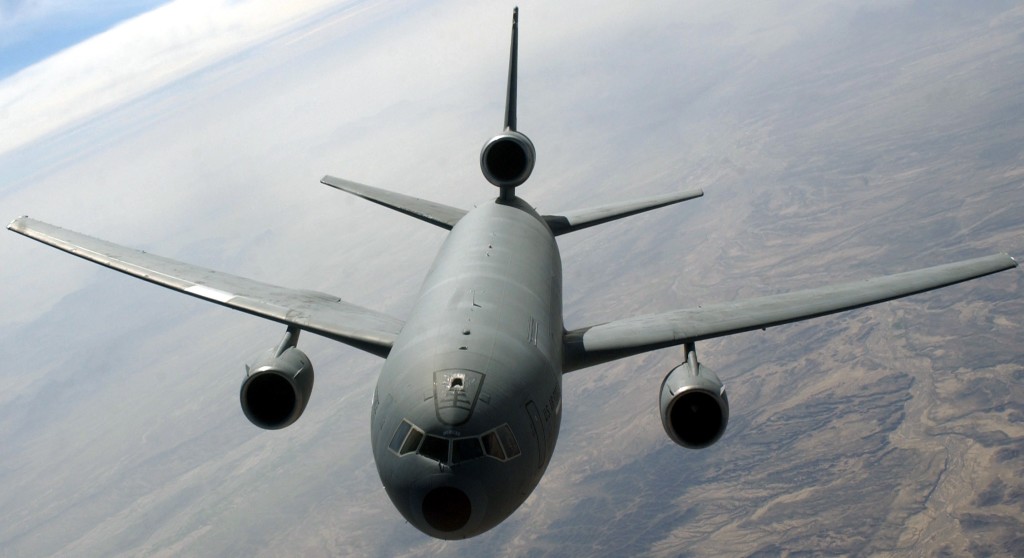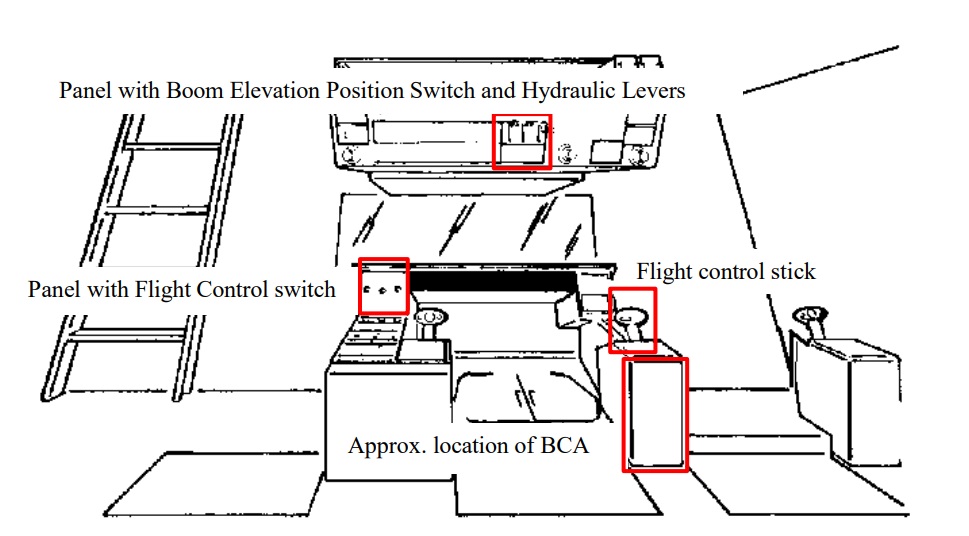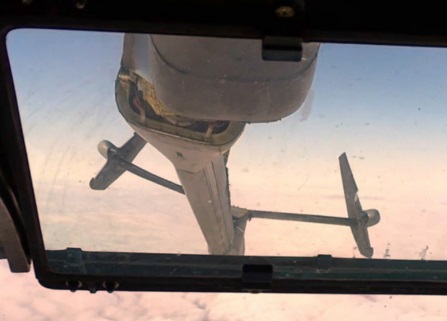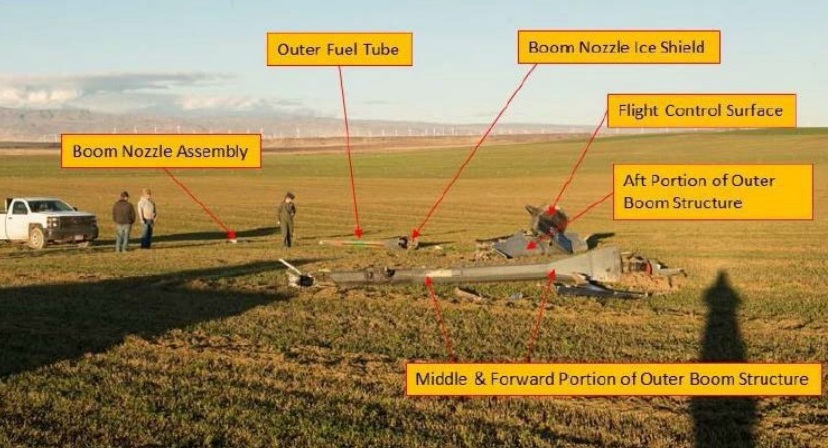‘Crazy’ KC-10 Boom Loss: Informal Maintenance Shift Handovers and Skipped Tasks
On 1 November 2016 US Air Force (USAF) Boeing KC-10A Extender tanker 83-0080 of the 60th Air Mobility Wing departed Travis Air Force Base (AFB), California for a training exercise.
As the crew prepared for aerial refuelling (AR) the Boom Operator lowered the Aerial Refuelling Boom.
The KC-10’s Boom Operator sits at the rear of the aircraft with a panoramic view and controls refuelling through a hand controller and a digital fly-by wire system.
The USAF Accident Investigation Board (AIB) reported that this was only the second time this boom had been lowered in-flight since major maintenance on 13 October 2016, just over 2 weeks earlier. On the first occasion (30 October 2016) the boom drifted to aircraft left approximately 10º-15º.
Based off of post-mishap analysis by the AIB, it was determined that the Boom Control Assembly (BCA) had a voltage bias in the roll axis to the aircraft’s left and the gimbal yoke assembly was out of design specification tolerances. After the aircraft returned, the crew informed maintenance of the boom’s actions.
Despite half of the rotary crank missing, the rotary drive shaft remained static and engaged with the crank while the boom was stowed.
Consequently, the maintenance personnel, did not detect the anomaly and released the aircraft for flight.
During the incident flight two days later on 1 November 2016:
Immediately after lowering the boom, it began to move erratically, oscillating to the aircraft’s right and left in a U-shaped pattern, well outside of its structural limits. After oscillating for approximately two minutes, the boom hoist cable broke.
The Boom Operator described the boom as having gone ‘crazy’.
Approximately two minutes later, the gimbal separated from the A-frame gimbal mounts, but remained connected to the fuselage by hydraulic and electrical lines.
[Ultimately] the boom completely separated from the aircraft and fell in an open field in Idaho.
[The crew safely] landed the aircraft at Mountain Home AFB, Idaho without incident. The total monetary value of government loss was $6,529,845.71.
The AIB president identified two causes:
The first cause of this mishap was a sheared Dual Rotary Voltage Transducer (DRVT) rotary crank that resulted from DRVT rotary bearing misalignment.
This was due to the earlier 10º-15º drift making the DVRT rotary crank contact the internal mechanical stop and causing it to shear.
This provided the aircraft’s boom control unit (BCU) with continuous, inaccurate roll position indications. As a result, the BCU compensated with lateral movement commands in both directions, driving the boom beyond its operational and structural limits.
The second cause, related to the first, was the [Boom Operator’s] failure to turn off the boom flight control switch in a timely manner. Turning off this switch would have disabled the BCU. This would have neutralized the boom flight control surfaces, and prevented the boom from departing the aircraft.
They also decided that “substantially contributing” was:
…the failure of maintenance personnel to comply with technical orders prevented the possible detection of an erratically performing DRVT…
In particular:
The 60th Maintenance Squadron (MXS) Hydraulics Section depended on informal hydraulics turnover logs and word of mouth instead of recording the completed task steps [as required by USAF procedures]. Additionally, the time required to remove and replace the gimbal assembly and to remove and reinstall the boom spanned over four shifts. The failure to annotate accomplished tasks properly, coupled with the length of time required to accomplish these maintenance procedures handicapped the successful completion of the corrective actions for this discrepancy.
Furthermore:
…the maintenance team did not complete Technical Order (TO) 1C-10(K)A-2-28, task 28- 71-04, paragraph 3B, Gimbal Install. [This] refers the maintenance member to install the boom IAW a different task (task 28-71-06). Maintenance personnel failed to refer back to the primary task (Gimbal Install), thereby failing to complete all applicable steps for a gimbal installation. Specifically, it appears that they did not perform step 17, which instructs maintenance personnel to conduct a DRVT polarity test by lowering the boom onto a maintenance dolly and moving it to aircraft left. If the team had referred back to the primary task and completed the remaining steps, they would have had an opportunity to detect the faulty component 17 days before the day of the mishap.
Disappointingly the AIB don’t probe the maintenance circumstances further, but they do note that:
…from 2011 to 2017, there have [only] been eight gimbals and two DRVTs replaced on the entire KC-10A fleet. …none of the qualified technicians interviewed had previously removed or replaced a gimbal yoke assembly or a DRVT.
Safety Resources
We also have written:
- Professor James Reason’s 12 Principles of Error Management
- Back to the Future: Error Management
- Safety Performance Listening and Learning – AEROSPACE March 2017
- Maintenance Human Factors: The Next Generation
- Airworthiness Matters: Next Generation Maintenance Human Factors
- B1900D Emergency Landing: Maintenance Standards & Practices
- United Airways Suffers from ED (Error Dysfunction)
- USAF RC-135V Rivet Joint Oxygen Fire: A military accident investigation has paradoxically determined that a $62.4mn fire was due to a maintenance error but that no human factors were involved.
- Inadequate Maintenance, An Engine Failure and Mishandling: Crash of a USAF WC-130H
- Inadequate Maintenance at a USAF Depot Featured in Fatal USMC KC-130T Accident
- USAF F-16C Crash at Joint Base Andrews: Engine Maintenance Error
- USAF Engine Shop in “Disarray” with a “Method of the Madness”: F-16CM Engine Fire
- MC-12W Loss of Control Orbiting Over Afghanistan: Lessons in Training and Urgent Operational Requirements
- Contaminated Oxygen on ‘Air Force One’ Poor standards at a Boeing maintenance facility resulted in contamination of two oxygen systems on a USAF Presidential VC-25 (B747).
- USAF Tool Trouble: “Near Catastrophic” $25mn E-8C FOD Fuel Tank Rupture
- AC-130J Prototype Written-Off After Flight Test LOC-I Overstress
- C-130 Fireball Due to Modification Error
- C-130J Control Restriction Accident, Jalalabad
- USAF Parachutist Fatally Extracted Through Ventilation Door
- Glider Controls Fail After Non Compliant Maintenance Embodying an AD
- ATR72 VH-FVR Missed Damage: Maintenance Lessons
- PA-34 Electrical Short Melted Rudder Cable
- UPDATE 6 December 2019: Dash 8 Q400 Return to Base After Pitot System Contaminated By Unapproved Test Kit Lubricant
- UPDATE 7 December 2019: Luftwaffe VVIP Global 5000 Written Off After Flying Control Assembly Error
- UPDATE 8 April 2020: NTSB Confirms United Airlines Maintenance Error After 12 Years
- UPDATE 30 June 2020: 17 Year Old FOD and a TA-4K Ejection
- UPDATE 27 December 2020: Fire-Fighting AS350 Hydraulics Accident: Dormant Miswiring
- UPDATE 15 March 2021: ATR 72 Rudder Travel Limitation Unit Incident: Latent Potential for Misassembly Meets Commercial Pressure
FSF Maintenance Observation Programme (MOP)
Aerossurance worked with the Flight Safety Foundation (FSF) to create a Maintenance Observation Program (MOP) requirement for their contractible BARSOHO offshore helicopter Safety Performance Requirements to help learning about routine maintenance and then to initiate safety improvements:
 Aerossurance can provide practice guidance and specialist support to successfully implement a MOP.
Aerossurance can provide practice guidance and specialist support to successfully implement a MOP.






Recent Comments